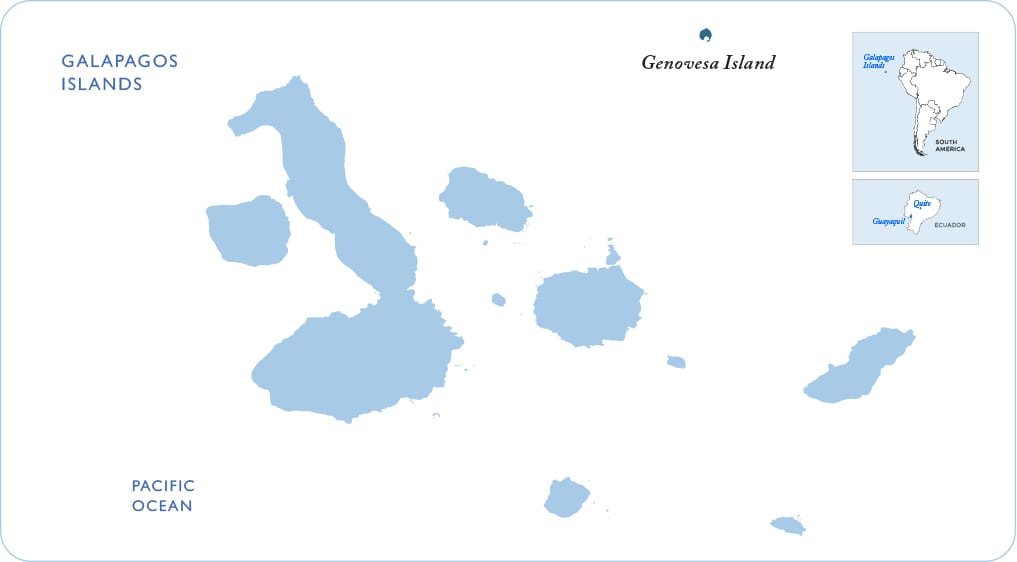- Home >
- Travel Guide >
- Galapagos Islands >
- About Galapagos >
- Genovesa Island >
About Genovesa Island in the Galapagos
Official Name: Genovesa Island
English Name: Tower Island
Visitor Sites: Darwin Bay Beach, Prince Phillip’s Steps
Area: 54 sq. miles (140 sq km)
Max altitude: 249 feet (76 meters)
Approximate Age: 2 million years old
Animals Regularly Seen: California Sea Lions, Swallow-tailed Gulls, Red-footed Boobies, Nazca Boobies, Blue-footed Boobies, Storm Petrels, Galapagos Mockingbird, Galapagos Dove, Great Frigate Birds, Lava Gulls, Fiddler Crabs.
Animals Occasionally or Seasonally Seen: Short-eared Owls, Red-billed Tropicbirds, Large Cactus Finch, Yellow-crowned Night Heron, Migratory Birds (Whimbrels, Ruddy Turnstones, Semipalmated Plover, Wandering Tattler).
Animals Rarely Seen: Waved Albatross, Sharks.
Outstanding characteristics: Bird Island! In Tower Island it is possible to observe red footed boobies, masked boobies, frigate birds and swallow-tailed gulls nesting. Moreover, red - billed tropic birds nest on the cliffs and short-eared owls are often spotted!
Vegetation: The vegetation of Tower Island is typical of the Arid Zone, the tree called palo santo (holy stick) is small in size and abundant.
Geology: Tower Island or Genovesa Island low-lying island whose lava originated primarily from a crater found in the center of the island, forming a shield volcano. The crater is circular, approximately 2000 feet wide at the rim and 200 feet deep, with a lake 1150 feet across on its floor.
Genovesa Island is possibly one of the most interesting Islands of the archipelago to visit on a Galapagos cruise! It could serve as a film set for a secret submarine base! The southwestern part of Tower Island is an ocean-filled caldera ringed by the outer edges of a sizeable and mostly submerged volcano. The island sits to the northeast, somewhat removed from the Galapagos archipelago. It is also known as "Bird Island", a name it lives up to in a spectacular way. Landing on the white coral sands of Darwin Bay and walking up the beach, you will be surrounded by the bustling activity of great frigate birds.
Puffball-chicks with their proud papas - who sport their bulging scarlet throat-sacks - crowd the surrounding branches, while both yellow-crowned and lava herons feed by the shore. Farther along you will discover a stunning series of sheltered pools set into a rocky outcrop, forming another natural film set. A trail beside the pools leads up to a cliff overlooking the caldera, where pairs of swallow-tailed gulls, the only nocturnal gulls in the world, can be seen nesting at the cliff's edge. Lava gulls and pintail ducks ride the sea breezes nearby.
Across the bay is Prince Philip's Steps, named for a visit by the British Monarch in 1964. The 25- meter (81-foot) stairway leads to a narrow stretch of land that opens out onto the plateau surrounding Darwin Bay, and extends to form the north side of the island. Red-footed boobies wrap their webbed feet around branches to perch in the bushes, and, in contrast, their "Nazca booby" cousins dot the surface of the scrublands beyond. Crossing through the sparse vegetation you will come to a broad lava field that extends towards the sea-this forms the north shore. Storm petrels flutter out over the ocean in swarms, then return to nest in the cracks and tunnels of the lava field, where their predator, the short-eared owl, is a frequent visitor.

